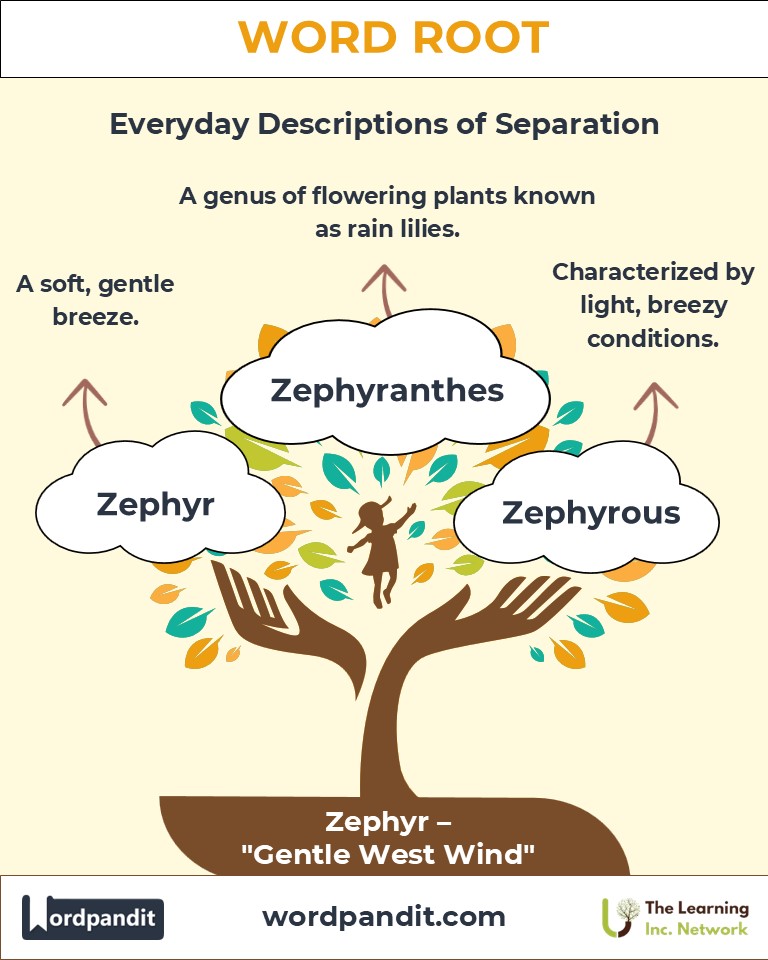Zephyr: The Gentle West Wind and Its Linguistic Breeze
Dive into the elegant charm of the root "Zephyr," derived from Greek mythology and denoting the west wind. From poetic expressions to specialized terminology, this root carries connotations of gentleness, breeziness, and serenity, enriching our language and imagination alike.

Table of Contents
- Introduction: The Essence of Zephyr
- Etymology and Historical Journey
- Mnemonic: Unlocking the Power of Zephyr
- Common Zephyr-Related Terms
- Zephyr Through Time
- Zephyr in Specialized Fields
- Illustrative Story: Zephyr in Action
- Cultural Significance of Zephyr
- The Zephyr Family Tree
- FAQs About the Zephyr Word Root
- Test Your Knowledge: Zephyr Word Root Quiz
- Conclusion: The Legacy of Zephyr
1. Introduction: The Essence of Zephyr
The word root Zephyr (pronounced ZEH-fuhr) originates from the Greek Zephyros, referring to the west wind—a gentle breeze that heralds spring and calm weather. Symbolic of lightness and tranquility, this term has inspired art, poetry, and technical applications. Let’s explore how "Zephyr" breathes life into language and culture.

2. Etymology and Historical Journey
The root "Zephyr" finds its origins in Greek mythology, where Zephyros was the personification of the west wind, often depicted as a bringer of mild weather and renewal. In Roman tradition, this name translated into Favonius, symbolizing favor and fertility. Over time, the root influenced terms in literature, technology, and even aerodynamics, consistently evoking ideas of lightness and motion.
3. Mnemonic: Unlocking the Power of Zephyr
To remember "Zephyr," visualize a gentle breeze swaying golden fields under a clear spring sky.
Mnemonic Device: "Zephyr zips softly, spreading spring's serene touch."
4. Common Zephyr-Related Terms
- Zephyr (ZEH-fuhr)
- Definition: A gentle, soft breeze.
- Example: "The zephyr carried the scent of blooming jasmine across the garden."
- Zephyrous (ZEH-fuh-ruhs)
- Definition: Characterized by or pertaining to the west wind.
- Example: "The zephyrous afternoon hinted at the arrival of spring."
- Zephyranthes (Zeh-fi-RAN-thees)
- Definition: A genus of flowering plants known as rain lilies.
- Example: "The garden was dotted with delicate zephyranthes after the morning rain."
- Zephyrette (ZEH-fuh-ret)
- Definition: A historical term for hostesses on passenger trains named after the west wind.
- Example: "The zephyrette ensured every traveler enjoyed a comfortable journey."
5. Zephyr Through Time
- Classical Poetry: Poets like Shelley and Keats used "Zephyr" to evoke nature’s delicate beauty, symbolizing renewal and inspiration.
- Modern Usage: The term now appears in technical names like "Zephyr Drone" and "Zephyr Framework," emphasizing lightness and innovation.
6. Zephyr in Specialized Fields
- Aeronautics:
- Zephyr Drone: A solar-powered aircraft designed for endurance and efficiency.
- Application: Used for atmospheric monitoring and communication.
- Botany:
- Zephyranthes: Plants with ethereal, ephemeral blooms, aptly named for their fleeting beauty.
- Literature:
- Usage: "Zephyr" conveys a light and gentle tone, often used to depict idyllic settings.
7. Illustrative Story: Zephyr in Action
In the tranquil countryside of Provence, a painter named Elise sought inspiration for her next masterpiece. One breezy morning, a zephyr rolled through the lavender fields, carrying with it a burst of floral fragrance and whispers of renewal. Elise captured the essence of that breeze on her canvas, calling the piece Zephyrous Symphony. The artwork won accolades, resonating with viewers who felt the serene touch of the west wind.
8. Cultural Significance of Zephyr
From Greek and Roman mythology to Renaissance art and modern branding, the root "Zephyr" signifies calmness, renewal, and elegance. Festivals and celebrations in spring often invoke the spirit of Zephyros, symbolizing nature’s rebirth and humanity’s enduring connection to the seasons.

9. The Zephyr Family Tree
- Aura (Latin): A soft breath or breeze.
- Example: "A calming aura surrounded the meadow."
- Favonius (Latin): The Roman god of the west wind.
- Example: "Favonius was celebrated as a harbinger of good weather."
- Flatus (Latin): A blowing or breeze.
- Example: "The flatus of the sea breeze brought relief from the summer heat."
10. FAQs About " Zephyr "
Q: What does "Zephyr" mean?
A: "Zephyr" refers to a soft, gentle breeze, often associated with the west wind. It embodies lightness, calm, and renewal, frequently used to describe a peaceful natural phenomenon or a metaphorical sense of tranquility.
Q: Who is Zephyros in mythology?
A: Zephyros is the Greek god of the west wind. In mythology, he was one of the four Anemoi (wind gods) and was considered the most benevolent, associated with spring and early summer. His gentle breeze brought growth and fertility to the land.
Q: What are some modern applications of "Zephyr"?
A: "Zephyr" appears in aeronautics, as in the "Zephyr Drone," a solar-powered aircraft emphasizing endurance and efficiency. It is also used in names for products, places, and literary works, reflecting elegance, lightness, and inspiration.
Q: What does "Zephyrous" mean?
A: "Zephyrous" describes conditions influenced by the west wind, characterized by light, breezy, or temperate weather. It often conveys a soothing, idyllic atmosphere.
Q: What is "Zephyranthes"?
A: "Zephyranthes" is a genus of flowering plants commonly known as rain lilies. These delicate blooms emerge after rainfall, aligning with the west wind’s association with renewal and growth.
Q: Why is "Zephyr" popular in literature and poetry?
A: Poets and writers use "Zephyr" to evoke imagery of peaceful landscapes, renewal, and the transient beauty of nature. Its lyrical quality adds a sense of grace and tranquility to creative works.
Q: What is a "Zephyrette"?
A: A "Zephyrette" was a term used in mid-20th century America to describe hostesses on passenger trains, specifically those serving on the luxurious "California Zephyr." Their name reflected the train’s theme of elegance and smooth service.
Q: How is the "Zephyr" root used metaphorically?
A: Beyond literal breezes, "Zephyr" symbolizes new beginnings, delicate changes, and gentle influences. It often serves as a metaphor for hope, inspiration, and lightness in life.
Q: What does "Zephyr" represent in branding and technology?
A: In branding, "Zephyr" conveys qualities of innovation, lightness, and subtle sophistication. In technology, it often describes products that are sleek, efficient, and eco-friendly, such as drones and lightweight frameworks.
11. Test Your Knowledge: " Zephyr " Mastery Quiz
1. What does "Zephyr" signify?
2. What is a "Zephyrette"?
3. Which field uses "Zephyr Drone"?
4. What does "Zephyrous" describe?
5. What plant is named after the west wind?
12. Conclusion: The Legacy of Zephyr
The root "Zephyr" gracefully carries the essence of gentleness and inspiration through language, science, and culture. From mythology to modern-day applications, it symbolizes the transformative power of the west wind. Let "Zephyr" remind us of life’s serene moments and the enduring beauty of nature.












